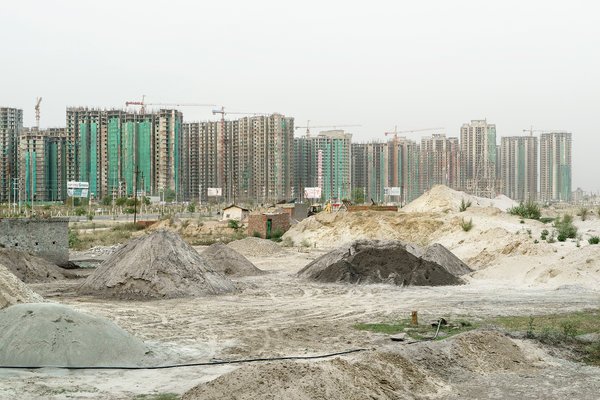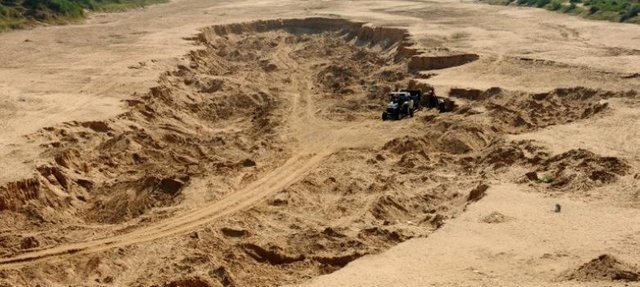Yesterday morning, when I was in the car on my way to work listening to the radio, I was surprised when I heard some news regarding the imminent sand shortage, becoming in a precious and scarce material in a few years. As I suppose it is happening the same to you, I was surprised and it sounded weird to me. How is it possible that something as abundant as the sand is going to disappear? -I said to myself. Once I got home I went to inquire and seek information about this subject and to my amazement, I found it to be true, we are running out of sand on planet Earth, what an irony ...

Apparently, at present, due to the level of prosperity seen in emerging countries like Brazil, China or India has led to a greater demand for sand to be used mainly in construction. Although there are huge amounts of sand and gravel on the Earth surface, its demand is insatiable and has no end: It is melted to transform into glass, from it are extracted minerals that are used for microchips without which there would be no computers nor the mobiles .... It helps us even to fly: in airplanes, plastics, light alloys of the fuselages and jet engines; even the paint and the wheels are made of sand. But mainly it is used to obtain the cement that we can find in the skyscrapers of Shanghai, the artificial islands of Dubai, freeways of Germany or in your own houses. In the last 150 years, sand, mixed with cement to form concrete, has carved out the contours of our increasingly urbanized world.
According to the United Nations Environment Program (UNEP), global average sand consumption reaches 40 billion tons per year, and about 30 billion tons are destined to the production of reinforced concrete. To give you an idea, with that amount you could build a wall that would almost surround the earth. "Sand is currently being mined at a higher rate than it is being renewed," the UNEP report says in March 2014. He concludes by saying that sand is "scarcer than we think."
The exploitation of sand and gravel is carried out all over the world and represents the largest volume of solid materials extraction worldwide. Also, these raw materials are the most consumed on the planet after water.
How does the sand form?
Sand is formed from erosive processes of rocks, stones, etc., which require thousands of years, however, at present it is exploited much faster than it regenerates. The absence of data on the extraction of sand makes it very difficult to assess the environmental risk, making this a problem largely ignored by the responsible authorities and practically unknown to the general population, for example by me before this week.
Some countries like Singapore have used the sand of their neighbors countries to expand their territory by up to 20% in the last 50 years. The importation of this sand was done legally, however it was their extraction that was sometimes carried out illegally. The sand of the coasts, once considered an inexhaustible resource, we now find that it has become a scarce material. Such is the point of shortage, that stealing it has become a very profitable practice for some illicit business and organizations.
In India, information about the existence of a "sand mafia" is daily published, a powerful organization in which even police and politicians are involved in. The situation is such that the government has forbidden the construction companies to use natural sand for their works.

One might think when reading all this: with the amount of sand there are in the deserts and that they do not take it, are they dumb? However it has an explanation. The reason is that the grains that make up the sand of the deserts are very eroded due to the action of the wind, they are very round and polished and they do not mix well. This sand is so fine that it is not suitable for producing cement because it requires a higher quality sand.
One might then think of using sand from the bottom of the sea, however, although this practice is technically feasible, it is not economically viable, since expensive processes are required to wash the sand in order to separate the salt it contains. Otherwise, structures built with this material could collapse in decades due to corrosion of the metal components. This practice would also cause erosion of the seabed and deterioration of its ecosystem. In some extreme cases, the extraction of marine aggregates has changed borders between countries, such as the disappearance of 25 sand islands in Indonesia.
Sometimes sand is also taken from rivers and lakes, but it is not sufficient to meet the growing demand for this material, which also causes loss of land by erosion of coastal and river areas and even including the increasing frequency and intensity of floods due to diversion of the river bed.

We are facing a global problem guys. It is necessary to regulate the extraction of sand in both national and international waters and should only be authorized if sound scientific evaluation shows that the environmental impact is minimal. At the same time alternatives should be sought and sustainable exploitation of resources could drastically reduce the negative impact on the environment.
Sand is indispensable for making everyday objects such as glass or concrete. To avoid the adoption of drastic measures, the industry has begun the search for alternatives, one being the elaboration of artificial sand from the grinding of stones with certain characteristics, which is becoming more relevant. Several researchers are working on the development of new materials such as recycled glass or brick substitutes that allow the concrete to be banished. In the meantime, some international authorities are attempting to raise awareness of a problem that is aggravating over the years. One thing is clear: when the sand is exhausted, we will not be able to turn back.
BIBLIOGRAPHY:
https://elpais.com/elpais/2014/10/10/planeta_futuro/1412951914_665326.html
https://www.clarin.com/construccion/mil-arenas_0_SkhvpBtDXg.html
https://www.greenfacts.org/es/extraccion-arena/
https://www.idealista.com/news/inmobiliario/vivienda/2015/07/30/738606-nos-estamos-quedando-sin-arena-y-es-todo-un-drama-inmobiliario
http://www.bbc.com/mundo/noticias/2014/08/140807_elementos_quimicos_silicio_finde_dv
http://www.rtve.es/television/20160525/noche-tematica-arena-nueva-fiebre-del-oro/760380.shtml
Interesting. One solution to cut down on concrete would be to start using hempcrete for houses and smaller buildings. Not sure it's practicality for larger structures but it's a start.
http://www.hempcrete.ca/
Downvoting a post can decrease pending rewards and make it less visible. Common reasons:
Submit
Really interesting, thanks for sharing!
Downvoting a post can decrease pending rewards and make it less visible. Common reasons:
Submit